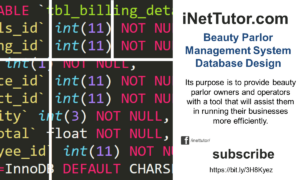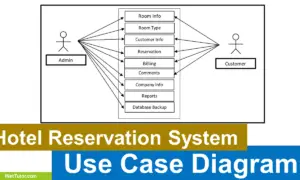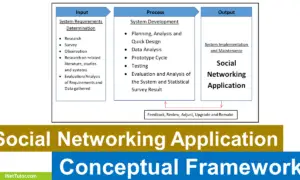Conceptual Framework of QR Code Based Collar for Livestock Breed Identification
Livestock breed identification is an essential process in the agricultural industry as it allows farmers to track their animals’ lineage, health, and productivity. However, manual identification can be time-consuming and prone to errors. This is where the QR code-based collar system comes into play. This system aims to provide an efficient and reliable way of identifying different livestock breeds using QR codes. In this article, we will delve into the conceptual framework of the QR Code-Based Collar for Livestock Breed Identification project, using the Input-Process-Output (IPO) model, and discuss how it can improve the agricultural industry’s livestock management.
About the Project
Table of Contents
Livestock breed identification is an essential aspect of livestock management. It helps farmers to keep accurate records of their animals and make informed decisions about breeding and sales. One of the newest innovations in livestock breed identification is the QR code based collar. This collar allows for quick and easy identification of livestock using a smartphone or other mobile device. In this blog post, we will explore the features and benefits of QR code based collars for livestock breed identification, and how they can help farmers to improve their livestock management practices. So, whether you’re a small-scale farmer or a large livestock operation, keep reading to learn how this technology can benefit you. The researchers proposed that a Livestock Breeding Identification utilizing QR Code Based Collar be attached to each livestock. The system read data from the collars attached to individual livestock. The technology will be able to read the QR Code on the collar, which provides all of the information needed to identify the breed of the particular livestock. These data are transferred to a central collection location, where a computer-based records system organizes, analyzes, and stores them. The technology would make it easier for livestock farmers to identify the breeds of the numerous animals on their farm. The technology will assist livestock farmers in making intelligent decisions in order to produce on-going generations of livestock on the farm.
Objectives of the Study
The general objective of the research study on QR Code Based Collar for Livestock Breed Identification is to develop a reliable and efficient method for identifying different breeds of livestock using QR codes and collars, aiming to improve the tracking and management of livestock for better breeding and productivity.
Specific Objectives:
- To develop a user-friendly QR code based collar design that can be easily attached to different types of livestock for breed identification.
- To create an efficient system that can accurately identify and classify various breeds of livestock using only QR codes.
- To design a robust and reliable scanning mechanism that can quickly and accurately read the QR codes on the animal’s collar to identify its breed.
- To develop a comprehensive database system that can store and manage all relevant information about different breeds of livestock for easy access and reference.
- To assess the overall effectiveness of the system in terms of its efficiency, productivity, quality, reliability, and maintainability, and identify areas for improvement.
What is a Conceptual Framework?
A conceptual framework is a structured approach that defines the research problem, objectives, hypotheses, and variables in a research study. It serves as a guide for researchers to conduct their study and provides a basis for analyzing data and drawing conclusions. In a capstone project, a conceptual framework helps to establish a clear direction for the project and provides a structure for organizing and analyzing data. It also helps in identifying the key variables and relationships between them. In the case of the QR Code Based Collar for Livestock Breed Identification, a conceptual framework will provide a basis for identifying the key variables, such as the design of the collar, the QR code scanning system, the repository of information on different breeds of livestock, and the evaluation criteria for the system.
Conceptual Framework Diagram
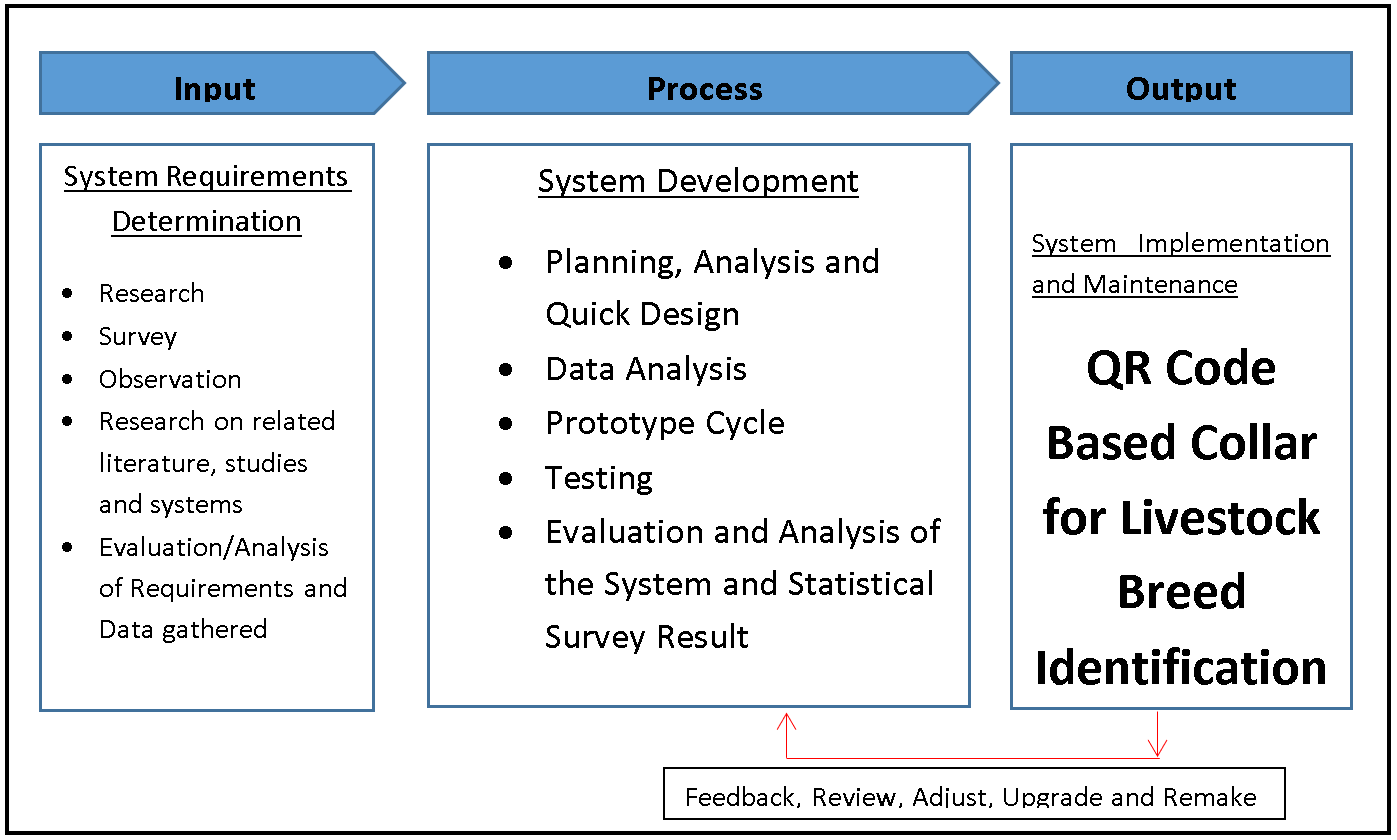
The image above depicts the project’s conceptual framework, entitled QR Code Based Collar for Livestock Breed Identification. It is based on the input, process, and output (IPO) model.
Input
The project will begin by evaluating the present process, which will lead to the stage of doing research, survey and observation. The researchers will also need to compile relevant papers and systems to use as a guide for the project’s development. After all such process, the researchers will evaluate and analyze the requirements and data gathered.
The input phase of the Input-Process-Output (IPO) model in the conceptual framework of a project involves the gathering of information necessary for the development of the system. This phase includes several components such as research, survey, observation, literature review, and evaluation/analysis of data gathered.
Research involves conducting an investigation to gather data and information relevant to the project. The research can be conducted through various means such as interviews, internet research, or fieldwork. Survey, on the other hand, involves the use of questionnaires to gather data from a target audience. Observation involves the direct observation of the subject matter to gather data.
In addition, a review of related literature, studies, and systems is also conducted to gather information and insights that can be used in the development of the system. Lastly, an evaluation and analysis of requirements and data gathered is conducted to determine their relevance and importance to the project. This phase is essential in the development of the conceptual framework as it provides the necessary information for the design and implementation of the system.
Process
The researchers will select and choose the optimum software development life cycle model for the project in this section.
Planning, Analysis and Quick Design
During Analysis and Quick Design, the researchers did a personal interview with the respondents and the chosen client where the study was conducted. The respondents were given the chance to suggest how the system will be designed. After conducting the data gathering, the researchers made an initial design for the proposed system.
Data analysis
Consultation is used to gather requirements from end users and generate ideas. We also distributed a survey questionnaire that was authorized by three experts (IT Expert, English Grammarian, and Researcher). And these questionnaires functioned as our data gathering tool, measuring the performance of the manual system that served as the foundation for the development of our proposed system.
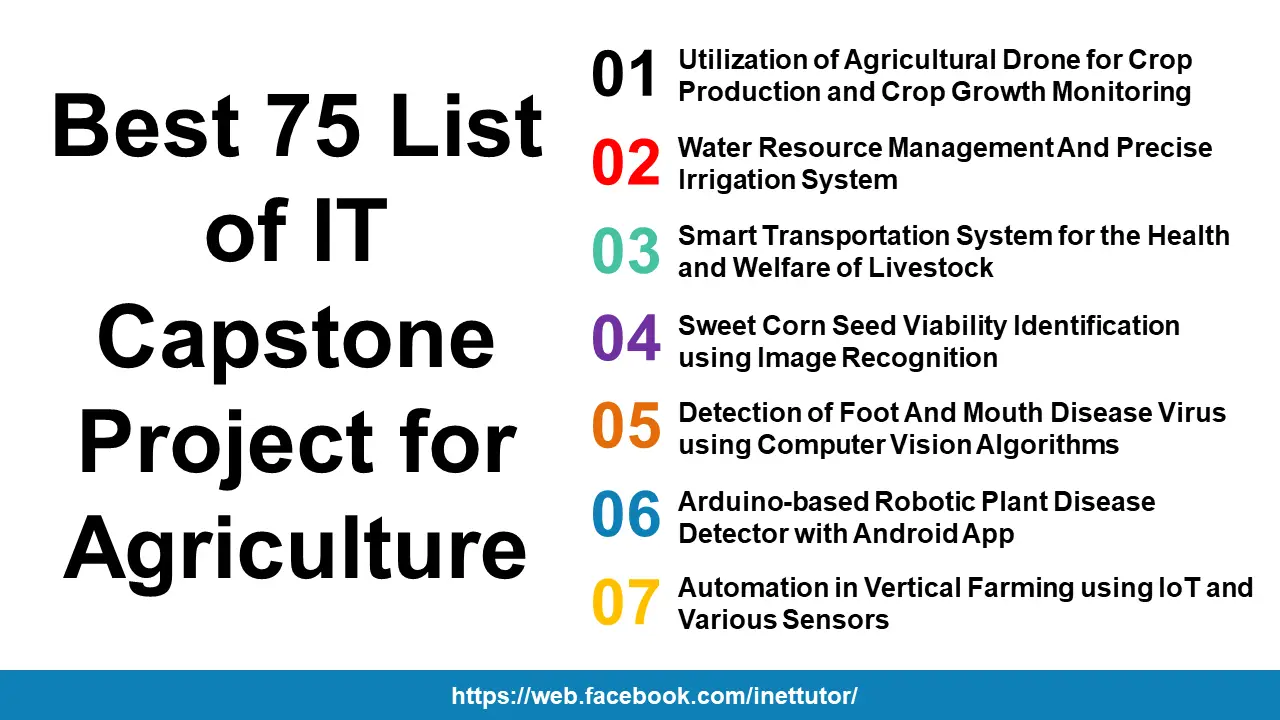
Prototype
The prototype and planned system features are developed at this phase. A concrete understanding of how the system will function is also created. We identify all of the necessary system inputs and outputs, as well as the design of data, processes, and interfaces, in this part.
Testing
In this phase, the researcher performed series of testing to check for any possible problems may arise during implementation and operation of the software and if the specification has been met.
Evaluation and Analysis of the System and Statistical Survey Result
This will include the feed backing of the proposed system after it will be implemented and had undergone testing by three Experts. It will also inform the researchers and the developer if there are any bugs, suggestion and if the system’s functionality will work well.
This will discuss the implementation of the proposed system wherein Three (3) Experts will evaluate the proposed system. This will also discuss if the recommended functions and suggestion are met.
Output
The project comes to life and is executed in the real world after all of the necessary procedures have been completed. A new project is born, and it will be maintained for the project’s long-term survival.
Implementing the QR Code Based Collar for Livestock Breed Identification offers several advantages. Firstly, it can provide a quick and accurate way of identifying different breeds of livestock using only a QR code, eliminating the need for time-consuming manual identification processes. This can save farmers and ranchers a significant amount of time and effort. Additionally, the system can serve as a repository of information about different breeds of livestock, which can be useful in making informed decisions about breeding, feeding, and management practices. Moreover, the system’s efficiency and reliability can contribute to the overall productivity and profitability of the livestock industry. Finally, the system’s ease of use and maintainability can lead to improved animal welfare and overall farm management.
Summary
The conceptual framework diagram of the QR Code Based Collar for Livestock Breed Identification is the topic of this research piece. The input, process, and output (IPO) model serves as the investigation’s conceptual framework. Research, Survey, Observation, Research on related literature, studies, and systems, and Evaluation/Analysis of Requirements and Data Collected are all part of the input phase. When the input stage is complete, the researchers will proceed to the process stage. The SDLC (Software Development Life Cycle) approach is used. Planning, Analysis and Quick Design, Data Analysis, Prototype Cycle, Testing and Evaluation, and System and Statistical Survey Result are all part of the SDLC technique. The output phase is the final stage before the produced system is implemented and used. The researchers will be present.
Readers are also interested in:
ICT Based Thesis and Capstone Project for Agriculture
Agriculture Consultancy and Customer Service Platform
You may visit our Facebook page for more information, inquiries, and comments. Please subscribe also to our YouTube Channel to receive free capstone projects resources and computer programming tutorials.
Hire our team to do the project.
